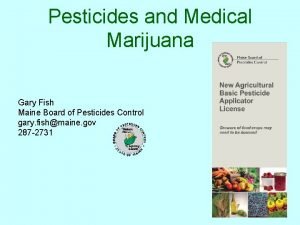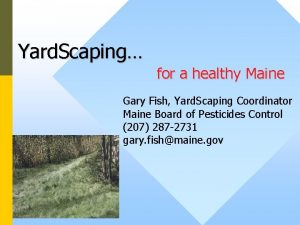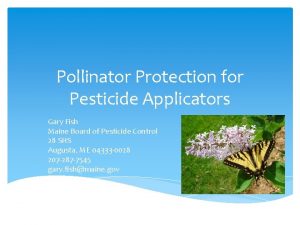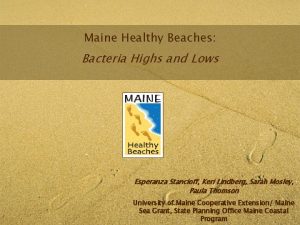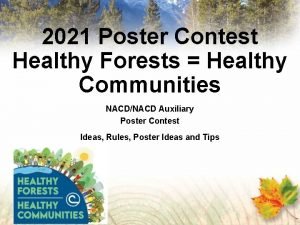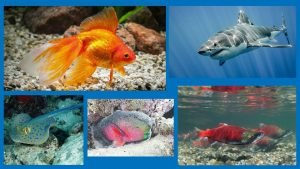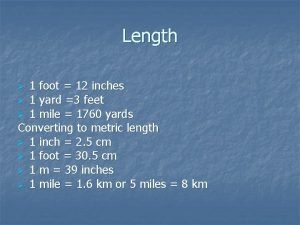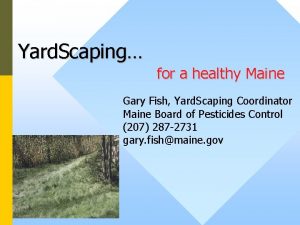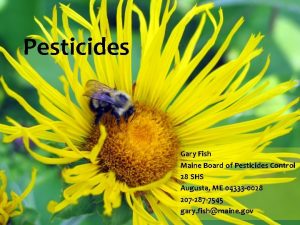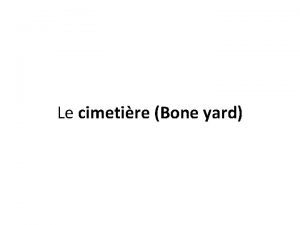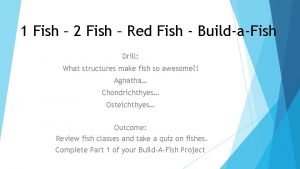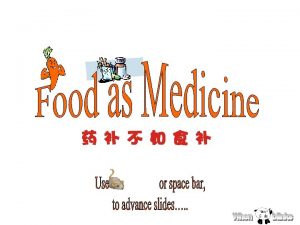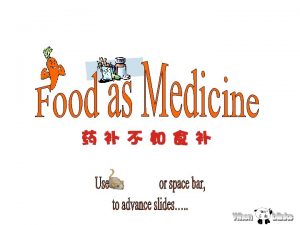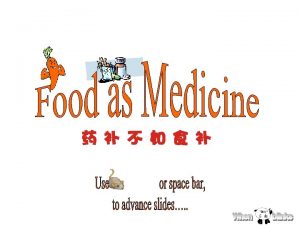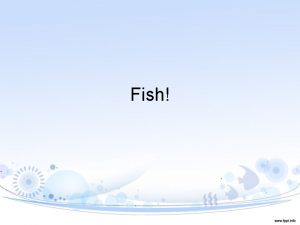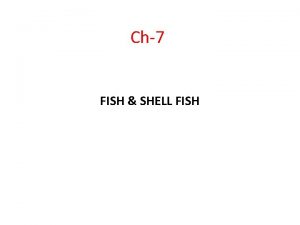Yard Scaping for a healthy Maine Gary Fish






























- Slides: 30

Yard. Scaping… for a healthy Maine Gary Fish, Yard. Scaping Coordinator Maine Board of Pesticides Control (207) 287 -2731 gary. fish@maine. gov

The Partnership is very diverse!

Yard. Scaping • A new paradigm? • Some call it “Sustainable Landscaping” or “Ecological Landscaping” • We want to keep it simple

Yard. Scaping Mission • To inspire Maine people to – create and maintain healthy landscapes – through ecologically based practices that – minimize reliance on water, fertilizer and pesticides

Maine pesticide use more common than perceived

Dramatic 3 x increase in use!

Bay. Scaping Project • Friends Of Casco Bay did some detective work in 2001, 2002, 2003, 2005 & 2006 • Sampled runoff water from intensive lawn care areas in Cumberland, S Portland, Westbrook, Falmouth, Yarmouth, Brunswick, Freeport, Portland Cape Elizabeth & Back Cove area • Sampled sediments for pyrethroids in 2006 – All samples were – “no detectable levels”

Friends of Casco Bay Sampling – 2001 Sampling • • • Found Diazinon in 1 of 3 samples (2. 6 ppb)** Found 2, 4 -D in all 3 samples (36. 4 ppb) Found Dicamba in 1 of 3 samples (3. 8 ppb) Found MCPP in 2 of 3 samples (26 ppb) Found Nitrogen & Phosphorous in all samples **Values in red exceed ALC – 2002 Sampling • Found Diazinon in 4 of 11 samples (. 71 ppb) • Found Nitrogen & Phosphorous in all samples – 2003 Sampling • • • Found Dicamba in 3 of 10 samples (4. 1 ppb) Found Clopyralid in 1 of 10 samples (0. 91 ppb) Found Propiconazole in 2 of 10 samples (0. 075 ppb)

Back Cove Project – 2005 Sampling • Found 2, 4 -D in 2 of 5 samples (4. 62 ppb) • Found MCPA in 2 of 5 samples (0. 45 ppb)

Aquatic Life Criteria • EPA criteria for nuisance algae growth – Nitrogen - 250 ppb Phosphorous – 20 ppb • EPA just proposed diazinon level of 0. 1 ppb for fresh water • Other criteria proposed by various sources for fresh water (from USGS Fact Sheet 097 -99) – 2, 4 -D – 4 ppb – MCPA – 2. 6 ppb – Carbaryl – 0. 02 ppb Dicamba – 10 ppb Triclopyr – 560 ppb Chlorpyrifos – 0. 001 ppb

USGS National Water Quality Assessment • Sampled urban streams – Insecticides occurred more frequently in urban streams than they did in agricultural area streams – Herbicides detected in 99% of Urban stream samples – Phosphorous found at same levels as in agricultural streams • 70% of those samples exceeded the EPA level for causing excessive algal growth

The Tenets of Yard. Scaping • Use site appropriate, non-invasive plants • Right plant, right place, right purpose • Use diversity of plants & grasses • Create wildlife habitats • Reduce lawn area • Use low input lawns & landscapes • Use vegetative buffers to protect surface waters • Reduce runoff • Reduce reliance on pesticides, fertilizers and water • Promote sensible pest management (IPM)

Use site appropriate, noninvasive plants • Native plants are well adapted – Fewer problems, less work, more rewards • Invasive plants are easy to grow but crowd out native vegetation – Our local forest habitats are changing rapidly – Invasive plants ruin wildlife habitat

Right plant, right place, right purpose • Choose plants based on the area to be planted not just for their color • Select plants that thrive under existing conditions rather than trying to alter the conditions to meet the needs of a plant • Minimize disturbance of the existing landscape

Right plant, right place Common Ninebark – dry sunny site Cinnamon Fern – wet shady site Staghorn Sumac – large open dry bank

Use a diversity of plants & grasses • Less noticeable damage from pests and disease • Incorporate many layers of plant types – Trees – Shrubs – Ground covers – Perennials, and – Lawns

Create wildlife habitats • Diversity and plant layers go hand in hand with habitat creation • Add nectar and fruit producing plants • Strive for continuous blooms • Add water, walls, feeders, woody debris

Reduce lawn area • Reduces – Water & air pollution – Water usage – Maintenance – Costs • Gives – More free time Mower exhaust = 40 small cars’ exhaust

Use low input plant varieties • No-mow fescue vs Kentucky bluegrass • Pagoda dogwood vs flowering cherry • River birch vs paper birch

Protect lakes & streams with buffers • Preserve existing landscape • Winding paths • Don’t mow to lake’s edge • Pitch the rake

Reduce runoff • Reduce amount of pervious (hard) surfaces • Create rain gardens or install rain barrels • Direct water into vegetated areas

Rain gardens are beautiful and functional

Reduce reliance on pesticides, fertilizers and water • Grow plants that are resistant to insects & diseases • Use plants that tolerate low fertility White Fir • Use drought resistant plants Sweet Fern

Use common sense pest management • Integrated pest management – Know your pest – Pick it, trap it or exclude it – Know the good bugs – Mow, prune or water – Use pesticides as last resort

Where to learn more http: //www. yardscaping. org

Where to learn more http: //www. maine. gov/agriculture/pesticides/gotpests/

Where to learn more http: //131. 128. 91. 217/maynard_susplants/html_spl 2000/index. htm

Where to learn more http: //orb. at. ufl. edu/TREES/index. html

Other resources • http: //www. hort. uconn. edu/ipm/turf/htms/turfman. htm http: //www. gardening. cornell. edu/lawn/almanac http: //www 03. cmhc-schl. gc. ca/b 2 c/catalog/products. do# http: //dspace. library. cornell. edu/bitstream/1813 /3574/2/Lawn+Care+without+Pesticides. pdf

Yard. Scaping… Protecting the beauty of Maine
 One fish two fish red fish blue fish ride
One fish two fish red fish blue fish ride Gary fish maine
Gary fish maine Gary fish maine
Gary fish maine Honey bee decline
Honey bee decline Kinnikinninck
Kinnikinninck Ammocoete
Ammocoete One fish, two fish, blowfish, blue fish
One fish, two fish, blowfish, blue fish Maine healthy beaches
Maine healthy beaches Healthy forests healthy communities poster contest
Healthy forests healthy communities poster contest Healthy nurse healthy nation
Healthy nurse healthy nation Nutrition and productivity
Nutrition and productivity Healthy soil healthy life poster ideas
Healthy soil healthy life poster ideas Whole shellfish
Whole shellfish A big fish swims up and swallows a small fish at rest
A big fish swims up and swallows a small fish at rest Diagram of male and female reproductive system of fish
Diagram of male and female reproductive system of fish Cartilaginous vs bony fish
Cartilaginous vs bony fish Osha yard tractor training
Osha yard tractor training James shahan
James shahan A freight train is being assembled in a switching yard
A freight train is being assembled in a switching yard Premeny jednotiek hmotnosti
Premeny jednotiek hmotnosti Scrap heap magnet diagram
Scrap heap magnet diagram Yard homograph
Yard homograph Construction material weights
Construction material weights Coj yard waste
Coj yard waste What makes some collisions elastic and others inelastic
What makes some collisions elastic and others inelastic 12 inches 1 foot
12 inches 1 foot Yard management system definition
Yard management system definition Elastic and inelastic collision
Elastic and inelastic collision Crook sitting position drawing
Crook sitting position drawing Imperial standard yard
Imperial standard yard Tony and sue are launching yard darts
Tony and sue are launching yard darts

